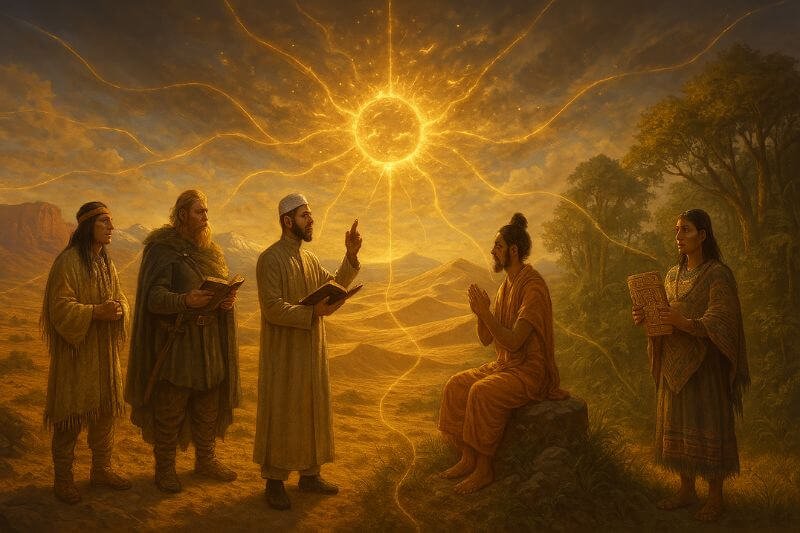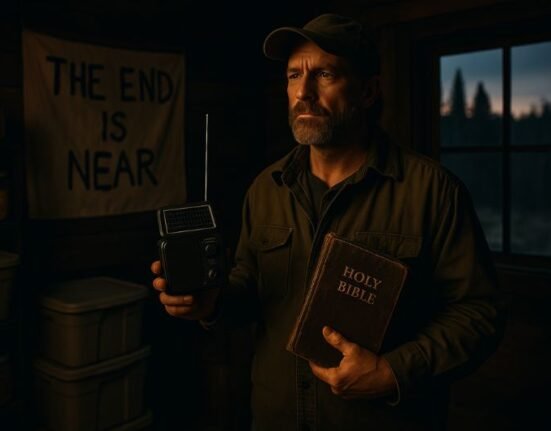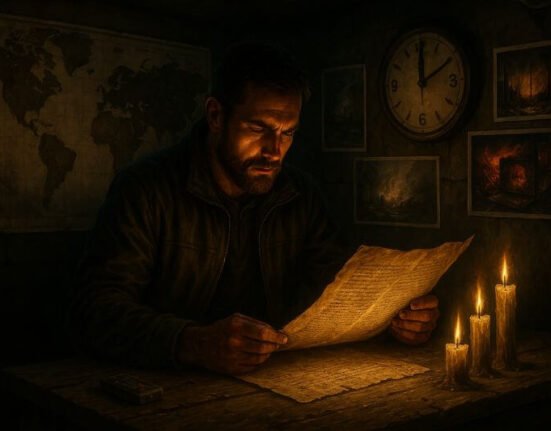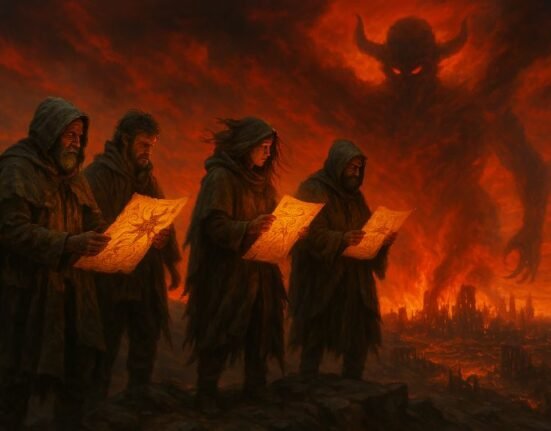End-time prophecies cultures have passed down reveal more than just visions of apocalypse—they reflect how societies interpret chaos, morality, and survival. From the deserts of Arabia to the highlands of Mesoamerica, nearly every civilization has envisioned its own version of the end. But while the symbols differ—floods, flames, beasts, or judgment—the core questions remain the same: What leads to collapse? Who survives it? And what comes after?
Understanding end-time prophecies across cultures isn’t just an academic curiosity—it’s a survival strategy. These narratives shape how communities prepare, respond, and rebuild after disaster. For modern preppers, exploring this eschatological diversity offers more than historical insight; it opens new dimensions of resilience—spiritual, tactical, and psychological.
This article compares some of the most influential prophetic frameworks from around the world—Hopi, Norse, Islamic, Hindu, and Mesoamerican—and what they teach us about enduring the end.
The Universality of the End: Why Every Culture Imagines Collapse
The instinct to envision the end of the world is not unique to any one religion or continent. It’s a recurring human impulse, deeply embedded in our collective psychology. Anthropologists like Mircea Eliade saw end-time myths as “myths of renewal”—symbolic death before rebirth.
Across cultures, end-time prophecies share striking similarities:
- A final judgment or reckoning
- A period of chaos or purification
- The appearance of messianic or apocalyptic figures
- A new world or restored order emerging after the fall
But what changes from culture to culture is the meaning, tone, and survival logic behind these narratives.
“Tell me how your world ends, and I’ll tell you who you are.” — Anthropological proverb
Understanding these differences helps preppers and survivalists not just prepare materially—but culturally and psychologically.
Common Patterns Across Civilizations
Let’s begin with the core similarities in end-time prophecies cultures have passed down:
| Element | Found in… | Meaning in Survivalist Terms |
|---|---|---|
| Global Catastrophe | Norse Ragnarök, Hindu Pralaya, Revelation | Collapse is inevitable—anticipate total system failure |
| Moral Decline | Hopi, Buddhist Kalachakra, Islamic traditions | Ethical decay as a pre-collapse signal |
| Divine Judgment | Abrahamic faiths, Zoroastrianism, Aztec myths | Behavior affects outcome—prep ethically |
| Purification Cycle | Hindu Yuga, Maya B’ak’tun, Hopi worlds | Collapse leads to rebirth—prep for long haul |
| Messianic Return | Mahdi, Kalki, Maitreya, Jesus, Quetzalcoatl | Expect sudden change—prep for radical disruption |
Why It Matters for Modern Survivalism
When prepping communities borrow from prophecy, they’re often influenced by just one worldview—typically Christian eschatology. But broadening our perspective opens up new interpretations, timelines, and responses.
- Hopi prophecies encourage community resilience and spiritual purification
- Hindu cycles teach adaptability and long-term vision
- Norse visions highlight valor in chaos—a warrior’s mindset
- Buddhist eschatology stresses inner transformation
By comparing end-time prophecies cultures have produced, we don’t just learn about their past—we build better, more adaptable survival strategies for our future.
Cultural Snapshots: Five Civilizations and Their Prophetic Visions
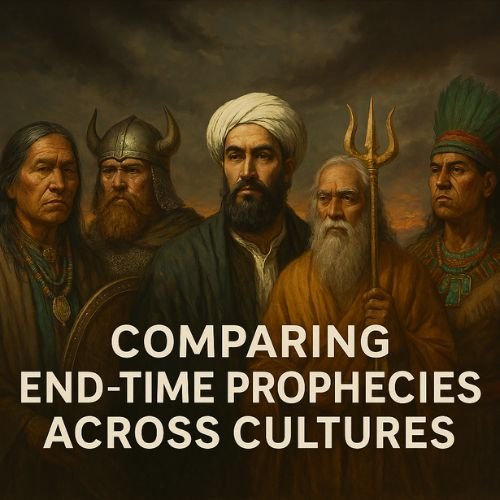
End-time prophecies don’t just reflect spiritual belief—they encode how different societies understood crisis, collapse, and renewal. By comparing five distinct cultural systems, we gain insight into how survival is conceptualized not just physically, but spiritually and psychologically.
Let’s examine how end-time prophecies cultures as varied as the Hopi, Norse, Islamic, Hindu, and Mesoamerican worlds shaped their views of the apocalypse—and how modern survivalists can draw from them.
🪶 The Hopi: Purification Through Simplicity
Origin: North American Southwest
Textual Source: Oral traditions, Blue Star Kachina prophecy
Core Message: When the world becomes spiritually imbalanced, it will be destroyed and renewed.
The Hopi envision a world cycling through destruction and rebirth. Their prophecy speaks of Four Worlds that have already ended due to moral failure, with the Fifth World on the horizon.
Key Signs:
- The appearance of the Blue Star Kachina
- Collapse of materialistic society
- Return to balance with Earth
➡️ Survivalist Interpretation:
Hopi prophecy emphasizes community resilience, respect for the land, and spiritual purification. It inspires preppers who embrace off-grid living, ecological awareness, and minimalism.
🛡️ The Norse: Ragnarök and the Warrior’s End
Origin: Scandinavia
Textual Source: Poetic Edda, Prose Edda
Core Message: The world ends in battle, fire, and flood—but is reborn from ashes.
In Norse mythology, Ragnarök is the final conflict between gods and giants, resulting in the death of key deities, burning of the world, and eventual renewal.
Key Signs:
- Fimbulwinter (a great winter of chaos)
- The release of Loki and monstrous creatures
- The death of gods like Odin and Thor
➡️ Survivalist Interpretation:
This worldview offers a stoic, warrior mindset: collapse is coming, and fighting with honor is more important than winning. Many modern preppers adopt this ethos to justify self-defense, training, and mental toughness.
☪️ The Islamic Tradition: Signs of the Hour
Origin: Arabian Peninsula
Textual Source: Qur’an, Hadith (Sahih Muslim, Abu Dawood, etc.)
Core Message: The End Times will be preceded by both minor and major signs, culminating in the appearance of the Mahdi, the Dajjal (Antichrist), and the return of Isa (Jesus).
Key Signs:
- Loss of trust and widespread corruption
- False prophets and spiritual confusion
- Natural disasters and societal breakdown
- Emergence of the Dajjal and return of Jesus
➡️ Survivalist Interpretation:
These prophecies are precise and sequential, often used as a checklist by Islamic preppers to time their actions. They emphasize moral clarity, spiritual discipline, and tactical readiness, especially in regions prone to political or religious instability.
🔱 Hinduism: The Cycle of Yugas and the Return of Kalki
Origin: Indian subcontinent
Textual Source: Puranas, Mahabharata, Bhagavata Purana
Core Message: Time moves in cycles (Yugas), with the current Kali Yuga (age of darkness) destined to end violently, followed by the rebirth of the world under Kalki.
Key Signs:
- Moral and spiritual decline
- Breakdown of caste and social order
- Environmental imbalance
- Rise of greed and ignorance
➡️ Survivalist Interpretation:
Hindu prophecy encourages long-term, cyclical thinking. Preppers influenced by these visions may prioritize mental clarity, sustainable routines, and family lineage protection, preparing for collapse not as a one-time event but as a recurring reality.
🐍 Mesoamerican (Maya & Aztec): Calendar Turns and Cosmic Cycles
Origin: Central America
Textual Source: Popol Vuh (Maya), Codex Borbonicus (Aztec)
Core Message: Time is cyclical; when a long count ends, a new world begins—often violently.
Popularly misinterpreted in the 2012 scare, the Maya didn’t predict the world’s destruction, but a major cosmic reset. Similarly, the Aztecs believed in Five Suns (ages), each ending in disaster (flood, fire, wind, jaguars…).
Key Signs:
- Completion of the 13th B’ak’tun
- Solar anomalies, societal inversion
- Natural catastrophe as divine correction
➡️ Survivalist Interpretation:
These visions frame collapse as a predictable reset, promoting adaptability, agility, and cosmological awareness. Many secular preppers use these cycles to justify minimalism and routine renewal of their preparedness strategies.
📌 Summary Table – Prophecies in Comparative View
| Culture | Collapse Trigger | Survival Ethic | Modern Prepper Application |
|---|---|---|---|
| Hopi | Spiritual imbalance | Simplicity, earth harmony | Off-grid life, land stewardship |
| Norse | Cosmic war | Courage, honor, fate | Warrior mindset, self-defense training |
| Islamic | Moral corruption, Dajjal | Faith, vigilance | Timeline prepping, moral clarity |
| Hindu | End of Kali Yuga | Purification, detachment | Long-term cycles, psychological prep |
| Mesoamerican | Calendar reset | Balance, offering, renewal | Seasonal prepping, minimalist rotation |
Global Lessons for Modern Preppers: What We Can Learn From Eschatological Diversity
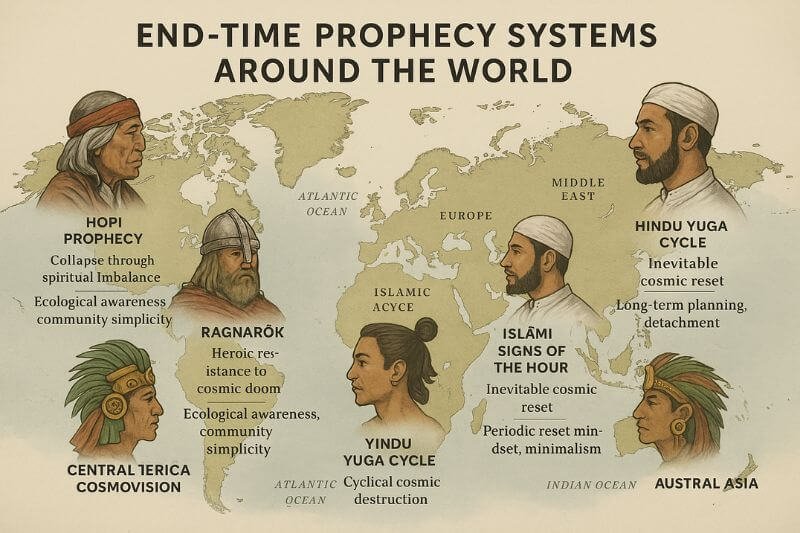
Understanding end-time prophecies cultures have developed isn’t just an intellectual exercise—it’s a strategic advantage. Each cultural framework offers a unique lens on survival, morality, community, and renewal. In a world increasingly defined by global risk and systemic fragility, these ancient visions may be more useful now than ever.
What Prophecies Teach That Data Can’t
Most modern prepping is built on risk analysis: economic indicators, climate models, political instability. Useful, yes—but incomplete.
Prophecies add something data cannot measure:
- Narrative meaning to chaos
- Moral guidance when laws fail
- Spiritual focus under psychological pressure
- Archetypal insight into human behavior in crisis
Where data informs, prophecy anchors.
“Data tells us what might happen. Prophecy tells us how to endure it.” — Survivalist philosopher J. Thorne
Cross-Cultural Wisdom for Practical Resilience
By studying diverse end-time prophecies cultures have cultivated, preppers can build layered resilience:
- Psychological: Stay mentally agile by accepting cyclical collapse (Hindu + Mesoamerican wisdom)
- Tactical: Train for combat and ethical discernment (Norse + Islamic models)
- Spiritual: Simplify and restore balance with your environment (Hopi + Buddhist teachings)
- Strategic: Read the signs, but live in the present (Christian + secular prophetic awareness)
This creates a multidimensional prepper—not just armed and stocked, but centered and informed.
End-Time Prophecy Systems Around the World
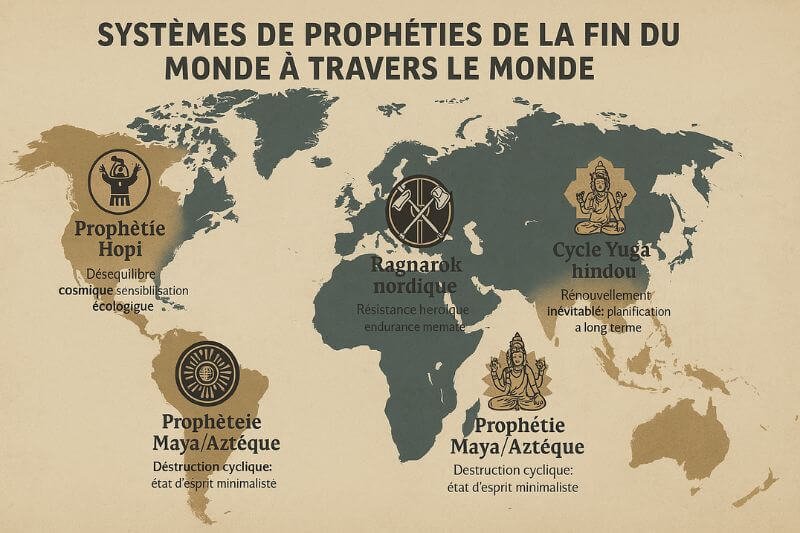
| Region | Prophetic Tradition | Core Concept | Prepper Relevance |
|---|---|---|---|
| North America | Hopi Prophecy | Collapse through spiritual imbalance | Ecological awareness, community simplicity |
| Europe | Norse Ragnarök | Heroic resistance to cosmic doom | Mental toughness, warrior ethos |
| Middle East | Islamic Signs of the Hour | Timeline of warning and deception | Moral vigilance, timeline prepping |
| South Asia | Hindu Yuga Cycle | Inevitable cosmic reset | Long-term planning, detachment |
| Central America | Mayan/Aztec Cosmovision | Cyclical cosmic destruction | Periodic reset mindset, minimalism |
Conclusion: Prophecy as a Cross-Cultural Survival Tool
The collapse you imagine defines the life you prepare.
Whether you’re guided by the Four Horsemen, the Kali Yuga, the Blue Star Kachina, or the rise of the Dajjal, your worldview shapes your survival plan. And in a globalized world, it’s no longer enough to understand just one version of the end.
The diversity of end-time prophecies cultures have passed down offers a vital reminder: there are many ways the world can end—and many ways to endure.
“To survive the next world-ending event, you must carry the wisdom of every fallen world before it.”
Read widely. Prepare wisely. Live resiliently.
🧠 Frequently Asked Questions (FAQ): Understanding End-Time Prophecies Cultures
Q: Why do so many cultures have end-time prophecies?
A: The existence of end-time prophecies cultures have passed down across millennia is no coincidence. These narratives respond to universal human anxieties—fear of death, fear of societal collapse, fear of moral decay. In every corner of the world, communities have developed stories that explain how the world ends and why it must end.
But more importantly, these prophecies also encode values. They reflect what a given culture cherishes most—and what it fears losing. In that sense, end-time prophecies are not only spiritual tools, but cultural compasses. They offer clues about what people believe must be preserved in the face of destruction: justice, order, the Earth, the soul.
“Where there’s prophecy, there’s culture—and where there’s culture, there’s a blueprint for survival.”
Q: Are these cultural prophecies useful for modern survivalists?
A: Absolutely. While modern prepping is often guided by science, data, and scenario analysis, there’s a growing recognition that narrative structures matter just as much. The diversity of end-time prophecies cultures have generated across centuries provides symbolic survival templates.
For instance:
- Hopi prophecy promotes reconnection to the land and community purification
- Norse Ragnarök encourages mental toughness and warrior resilience
- Islamic eschatology warns against deception and calls for spiritual vigilance
- Hindu cycles emphasize long-term vision and detachment from material chaos
- Mayan cosmic resets teach cyclical thinking and adaptability
Each tradition contributes to a mental survival map—not based on fear, but on foresight. Preppers who study these prophecies gain insight into how to think under pressure, not just what to stock.
Q: Isn’t it risky to base survival planning on mythology?
A: It can be—if taken literally and uncritically. But when approached symbolically, the end-time prophecies cultures have produced become narrative lenses, not fixed instructions.
Rather than predicting the future, these myths help us frame our relationship to collapse. They shape how we:
- Identify signs of systemic failure
- Interpret moral and cultural decline
- Structure long-term thinking and resilience
- Cultivate emotional and psychological preparedness
For example, believing the “Beast” represents AI surveillance doesn’t mean you expect a horned creature to rise—it means you’re critically aware of digital authoritarianism and prepping for decentralization.
➡️ In this light, mythology is not a risk—it’s a strategic asset.
Q: Can comparing prophecies help with cultural prepping?
A: Without question. In a globally interconnected world, understanding how different cultures interpret collapse helps build cross-cultural resilience.
For preppers, this is more than cultural appreciation—it’s practical adaptation. Here’s why:
- In multicultural urban zones, knowing other communities’ eschatological fears can help anticipate behavior during crises (panic, withdrawal, aggression, migration).
- In global supply chain collapse, being aware of how different cultures respond to scarcity and chaos allows for better cooperation or avoidance.
- For international preppers or expatriates, cultural prophecy knowledge becomes a soft-skill survival tool.
Moreover, studying end-time prophecies cultures have developed fosters psychological diversity in your prepping philosophy. It breaks the echo chamber of Western collapse narratives and introduces new ways to anticipate, endure, and rebuild.









